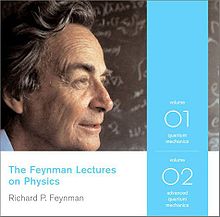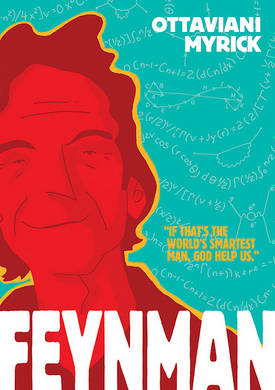Richard P. Feynman
|
|
This post was updated on .
Someone asked me about him. As my memory failed me all the time. I really couldn't name his books.
Here they are. The Meaning of It All: Thoughts of a Citizen-Scientist The Pleasure of Finding Things Out "What Do You Care What Other People Think?": Further Adventures of a Curious Character Six Easy Pieces Perfectly Reasonable Deviations From The Beaten Track: The Letters Of Richard P. Feynman |
|
|
|
|
Science/Religion conflict:
http://www.youtube.com/watch?v=9BVFAYF7zHE Wave/Particle duality: http://www.youtube.com/watch?v=_7OEzyEfzgg Comfortable with uncertainty: http://www.youtube.com/watch?v=_MmpUWEW6Is History is irrelevant plus curiousity: http://www.youtube.com/watch?v=PsgBtOVzHKI Feynman's Vision: The Next 50 Years TEDxCaltech http://tedxcaltech.com |
|
|
In reply to this post by XOX
|
|
|
This post was updated on .
 THE RELATION OF SCIENCE AND RELIGION Some fresh observations on an old problem by RICHARD P. FEYNMAN "The Relation of Science and Religion" is a transcript of a talk given by Dr. Feynman at the Caltech YMCA Lunch Forum on May 2, 1956. http://calteches.library.caltech.edu/49/2/Religion.htm ...Western civilization, it seems to me, stands by two great heritages. One is the scientific spirit of adventure — the adventure into the unknown, an unknown which must be recognized as being unknown in order to be explored; the demand that the unanswerable mysteries of the universe remain unanswered; the attitude that all is uncertain; to summarize it — the humility of the intellect. The other great heritage is Christian ethics — the basis of action on love, the brotherhood of all men, the value of the individual — the humility of the spirit. These two heritages are logically, thoroughly consistent. But logic is not all; one needs one’s heart to follow an idea. If people are going back to religion, what are they going back to? Is the modern church a place to give comfort to a man who doubts God — more, one who disbelieves in God? Is the modern church a place to give comfort and encouragement to the value of such doubts? So far, have we not drawn strength and comfort to maintain the one or the other of these consistent heritages in a way which attacks the values of the other? Is this unavoidable? How can we draw inspiration to support these two pillars of western civilization so that they may stand together in full vigor, mutually unafraid? Is this not the central problem of our time? http://www.cosmicfingerprints.com/feynman/ |
|
|
In reply to this post by XOX
Richard Feynman, the Thinker
by George Johnson April 1, 2011 NY Times http://www.nytimes.com/2011/04/03/books/review/book-review-quantum-man-richard-feynmans-life-in-science-by-lawrence-m-krauss.html The 'Dramatic Picture' of Richard Feynman by Freeman Dysone July 14, 2011 The New York Review of Books http://www.nybooks.com/articles/archives/2011/jul/14/dramatic-picture-richard-feynman/ ...The title of Krauss’s book, Quantum Man, is well chosen. The central theme of Feynman’s work as a scientist was to explore a new way of thinking and working with quantum mechanics. The book succeeds in explaining without any mathematical jargon how Feynman thought and worked. This is possible because Feynman visualized the world with pictures rather than with equations. Other physicists in the past and present describe the laws of nature with equations and then solve the equations to find out what happens. Feynman skipped the equations and wrote down the solutions directly, using his pictures as a guide. Skipping the equations was his greatest contribution to science. By skipping the equations, he created the language that a majority of modern physicists speak. Incidentally, he created a language that ordinary people without mathematical training can understand. To use the language to do quantitative calculations requires training, but untrained people can use it to describe qualitatively how nature behaves. Feynman’s picture of the world starts from the idea that the world has two layers, a classical layer and a quantum layer. Classical means that things are ordinary. Quantum means that things are weird. We live in the classical layer. All the things that we can see and touch and measure, such as bricks and people and energies, are classical. We see them with classical devices such as eyes and cameras, and we measure them with classical instruments such as thermometers and clocks. The pictures that Feynman invented to describe the world are classical pictures of objects moving in the classical layer. Each picture represents a possible history of the classical layer. But the real world of atoms and particles is not classical. Atoms and particles appear in Feynman’s pictures as classical objects, but they actually obey quite different laws. They obey the quantum laws that Feynman showed us how to describe by using his pictures. The world of atoms belongs to the quantum layer, which we cannot touch directly. The primary difference between the classical layer and the quantum layer is that the classical layer deals with facts and the quantum layer deals with probabilities. In situations where classical laws are valid, we can predict the future by observing the past. In situations where quantum laws are valid, we can observe the past but we cannot predict the future. In the quantum layer, events are unpredictable. The Feynman pictures only allow us to calculate the probabilities that various alternative futures may happen. The quantum layer is related to the classical layer in two ways. First, the state of the quantum layer is what is called “a sum-over-histories,” that is, a combination of every possible history of the classical layer leading up to that state. Each possible classical history is given a quantum amplitude. The quantum amplitude, otherwise known as a wave function, is a number defining the contribution of that classical history to that quantum state. Second, the quantum amplitude is obtained from the picture of that classical history by following a simple set of rules. The rules are pictorial, translating the picture directly into a number. The difficult part of the calculation is to add up the sum-over-histories correctly. The great achievement of Feynman was to show that this sum-over-histories view of the quantum world reproduces all the known results of quantum theory, and allows an exact description of quantum processes in situations where earlier versions of quantum theory had broken down. Feynman was radical in his disrespect for authority, but conservative in his science. When he was young he had hoped to start a revolution in science, but nature said no. Nature told him that the existing jungle of scientific ideas, with the classical world and the quantum world described by very different laws, was basically correct. He tried to find new laws of nature, but the result of his efforts was in the end to consolidate the existing laws in a new structure. He hoped to find discrepancies that would prove the old theories wrong, but nature stubbornly persisted in proving them right. However disrespectful he might be to famous old scientists, he was never disrespectful to nature. Toward the end of Feynman’s life, his conservative view of quantum science became unfashionable. The fashionable theorists reject his dualistic picture of nature, with the classical world and the quantum world existing side by side. They believe that only the quantum world is real, and the classical world must be explained as some kind of illusion arising out of quantum processes. They disagree about the way in which quantum laws should be interpreted. Their basic problem is to explain how a world of quantum probabilities can generate the illusions of classical certainty that we experience in our daily lives. Their various interpretations of quantum theory lead to competing philosophical speculations about the role of the observer in the description of nature. Feynman had no patience for such speculations. He said that nature tells us that both the quantum world and the classical world exist and are real. We do not understand precisely how they fit together. According to Feynman, the road to understanding is not to argue about philosophy but to continue exploring the facts of nature. In recent years, a new generation of experimenters has been advancing along Feynman’s road with great success, moving into the new worlds of quantum computing and quantum cryptography. ... |
|
|
In reply to this post by XOX
A Graphic Novel Biography of Richard Feynman
http://www.brainpickings.org/index.php/2011/10/14/richard-feynman-graphic-novel-biography-ottoviani/ 
|
|
|
In reply to this post by XOX
Richard Feynman
11 May 2013 Quick Physics http://quickphysics.blogspot.hk/2013/05/richard-feynman.html Alex's comment: A great bio of Richard Feynman. |
|
|
In reply to this post by XOX
You Can Now Access All Of Richard Feynman's Physics Lectures For Free
http://io9.com/you-can-now-access-all-of-richard-feynmans-physics-lect-1627809095 |
|
|
«
Return to Atheism, Humanism, Naturalism 無神論、人文主義、自然主義
|
1 view|%1 views
| Free forum by Nabble | Edit this page |

